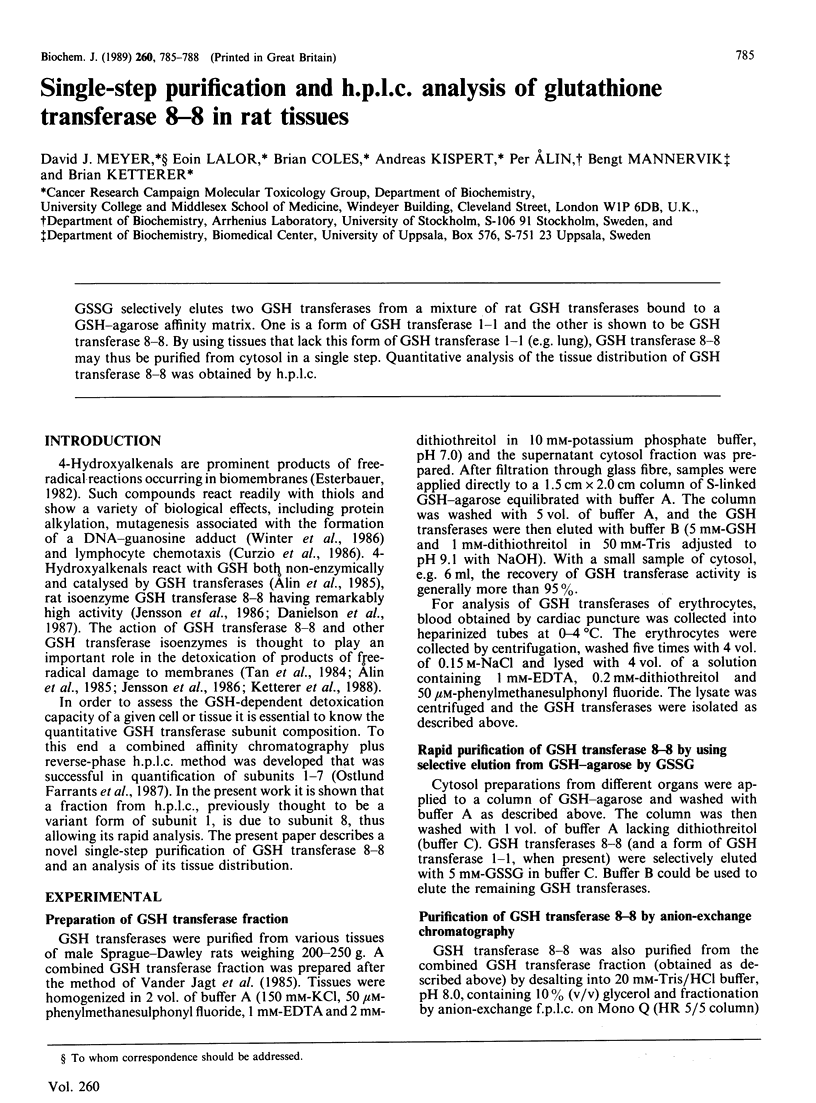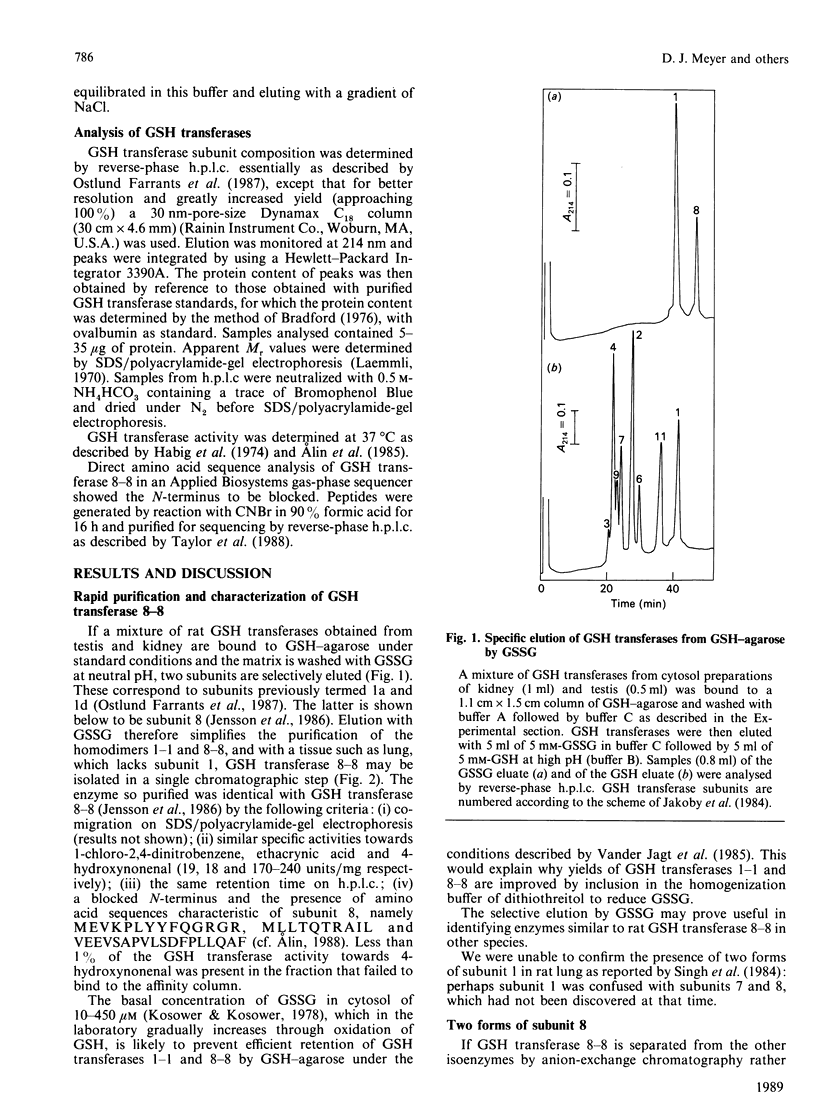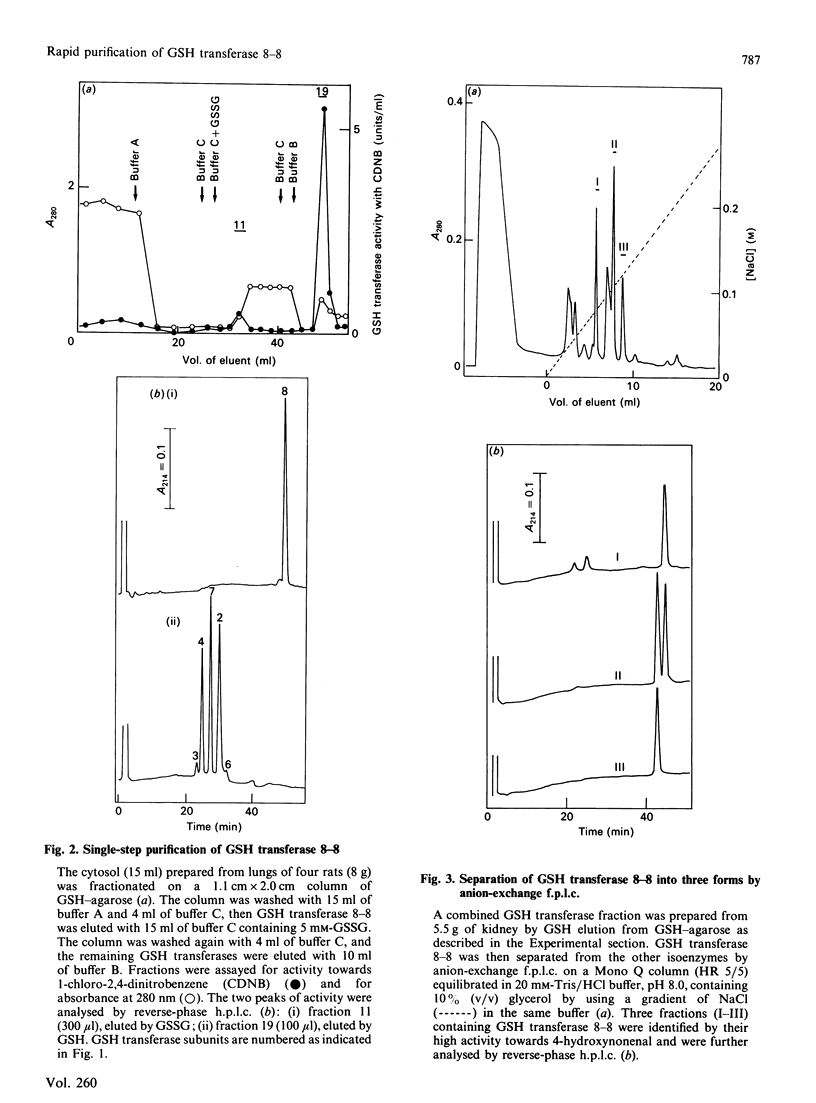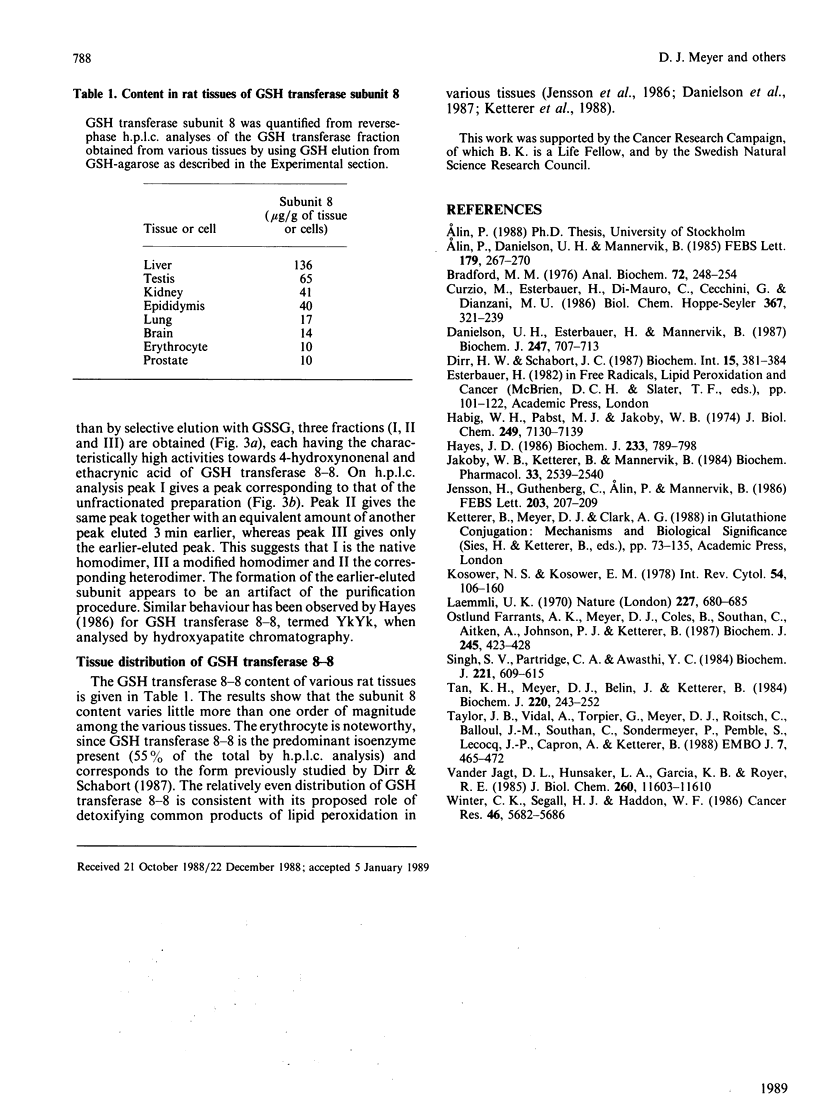Abstract
GSSG selectively elutes two GSH transferases from a mixture of rat GSH transferases bound to a GSH-agarose affinity matrix. One is a form of GSH transferase 1-1 and the other is shown to be GSH transferase 8-8. By using tissues that lack this form of GSH transferase 1-1 (e.g. lung), GSH transferase 8-8 may thus be purified from cytosol in a single step. Quantitative analysis of the tissue distribution of GSH transferase 8-8 was obtained by h.p.l.c.
Full text
PDF



Selected References
These references are in PubMed. This may not be the complete list of references from this article.
- Alin P., Danielson U. H., Mannervik B. 4-Hydroxyalk-2-enals are substrates for glutathione transferase. FEBS Lett. 1985 Jan 7;179(2):267–270. doi: 10.1016/0014-5793(85)80532-9. [DOI] [PubMed] [Google Scholar]
- Bradford M. M. A rapid and sensitive method for the quantitation of microgram quantities of protein utilizing the principle of protein-dye binding. Anal Biochem. 1976 May 7;72:248–254. doi: 10.1016/0003-2697(76)90527-3. [DOI] [PubMed] [Google Scholar]
- Curzio M., Esterbauer H., Di Mauro C., Cecchini G., Dianzani M. U. Chemotactic activity of the lipid peroxidation product 4-hydroxynonenal and homologous hydroxyalkenals. Biol Chem Hoppe Seyler. 1986 Apr;367(4):321–329. doi: 10.1515/bchm3.1986.367.1.321. [DOI] [PubMed] [Google Scholar]
- Danielson U. H., Esterbauer H., Mannervik B. Structure-activity relationships of 4-hydroxyalkenals in the conjugation catalysed by mammalian glutathione transferases. Biochem J. 1987 Nov 1;247(3):707–713. doi: 10.1042/bj2470707. [DOI] [PMC free article] [PubMed] [Google Scholar]
- Dirr H. W., Schabort J. C. Glutathione S-transferase composition of rat erythrocytes. Biochem Int. 1987 Aug;15(2):381–384. [PubMed] [Google Scholar]
- Habig W. H., Pabst M. J., Jakoby W. B. Glutathione S-transferases. The first enzymatic step in mercapturic acid formation. J Biol Chem. 1974 Nov 25;249(22):7130–7139. [PubMed] [Google Scholar]
- Hayes J. D. Purification and physical characterization of glutathione S-transferase K. Differential use of S-hexylglutathione and glutathione affinity matrices to isolate a novel glutathione S-transferase from rat liver. Biochem J. 1986 Feb 1;233(3):789–798. doi: 10.1042/bj2330789. [DOI] [PMC free article] [PubMed] [Google Scholar]
- Jakoby W. B., Ketterer B., Mannervik B. Glutathione transferases: nomenclature. Biochem Pharmacol. 1984 Aug 15;33(16):2539–2540. doi: 10.1016/0006-2952(84)90621-x. [DOI] [PubMed] [Google Scholar]
- Jensson H., Guthenberg C., Alin P., Mannervik B. Rat glutathione transferase 8-8, an enzyme efficiently detoxifying 4-hydroxyalk-2-enals. FEBS Lett. 1986 Jul 28;203(2):207–209. doi: 10.1016/0014-5793(86)80743-8. [DOI] [PubMed] [Google Scholar]
- Kosower N. S., Kosower E. M. The glutathione status of cells. Int Rev Cytol. 1978;54:109–160. doi: 10.1016/s0074-7696(08)60166-7. [DOI] [PubMed] [Google Scholar]
- Laemmli U. K. Cleavage of structural proteins during the assembly of the head of bacteriophage T4. Nature. 1970 Aug 15;227(5259):680–685. doi: 10.1038/227680a0. [DOI] [PubMed] [Google Scholar]
- Ostlund Farrants A. K., Meyer D. J., Coles B., Southan C., Aitken A., Johnson P. J., Ketterer B. The separation of glutathione transferase subunits by using reverse-phase high-pressure liquid chromatography. Biochem J. 1987 Jul 15;245(2):423–428. doi: 10.1042/bj2450423. [DOI] [PMC free article] [PubMed] [Google Scholar]
- Singh S. V., Partridge C. A., Awasthi Y. C. Rat lung glutathione S-transferases. Evidence for two distinct types of 22000-Mr subunits. Biochem J. 1984 Aug 1;221(3):609–615. doi: 10.1042/bj2210609. [DOI] [PMC free article] [PubMed] [Google Scholar]
- Tan K. H., Meyer D. J., Belin J., Ketterer B. Inhibition of microsomal lipid peroxidation by glutathione and glutathione transferases B and AA. Role of endogenous phospholipase A2. Biochem J. 1984 May 15;220(1):243–252. doi: 10.1042/bj2200243. [DOI] [PMC free article] [PubMed] [Google Scholar]
- Taylor J. B., Vidal A., Torpier G., Meyer D. J., Roitsch C., Balloul J. M., Southan C., Sondermeyer P., Pemble S., Lecocq J. P. The glutathione transferase activity and tissue distribution of a cloned Mr28K protective antigen of Schistosoma mansoni. EMBO J. 1988 Feb;7(2):465–472. doi: 10.1002/j.1460-2075.1988.tb02834.x. [DOI] [PMC free article] [PubMed] [Google Scholar]
- Vander Jagt D. L., Hunsaker L. A., Garcia K. B., Royer R. E. Isolation and characterization of the multiple glutathione S-transferases from human liver. Evidence for unique heme-binding sites. J Biol Chem. 1985 Sep 25;260(21):11603–11610. [PubMed] [Google Scholar]
- Winter C. K., Segall H. J., Haddon W. F. Formation of cyclic adducts of deoxyguanosine with the aldehydes trans-4-hydroxy-2-hexenal and trans-4-hydroxy-2-nonenal in vitro. Cancer Res. 1986 Nov;46(11):5682–5686. [PubMed] [Google Scholar]


